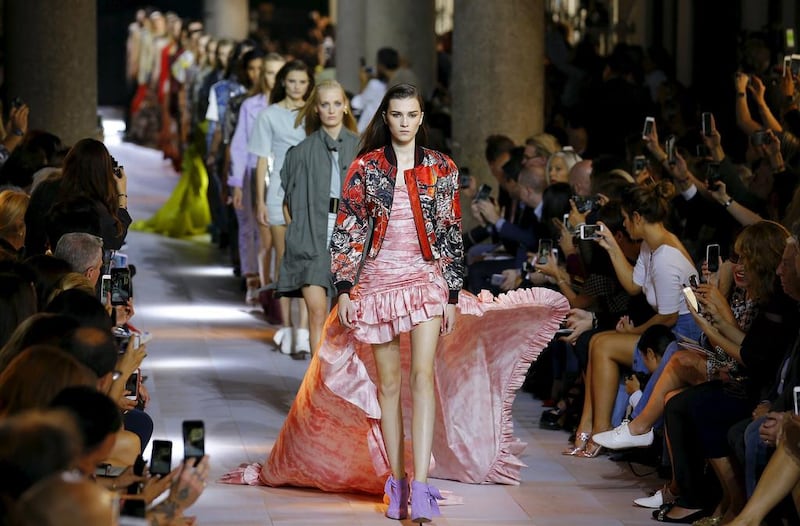There is a bit of a shake-up going on in Milan right now as the new spring 2016 collections come to a close. The mood for change has been in the air for a while but new designers at Gucci and Pucci, and a changing of the guard at Roberto Cavalli, herald a fresh approach at these houses.
Roberto Cavalli, now in the hands of Peter Dundas, who worked for 10 years as head of design at Cavalli with Roberto’s wife, Eva, before moving on to revamp Emilio Pucci, is signalling a little more carefree and lighter spirited sensibility for the label. Meanwhile his successor at Pucci, Massimo Giorgetti, like Alessandro Michele at Gucci, has presented a vision that steers in a completely different direction to that of his predecessor.
Sizzling sex appeal has fizzled out of fashion like a barbecue on a wet day – a surprise in a city that is renowned for va-va-voom dressing. However, life is not one long cocktail party, as Donatella Versace notes. Even she has toughened up the Versace look with camouflage and combat gear, albeit ultra-short, worn with socks and clogs or flatforms, although how politically correct that is at the moment is open to debate.
Peter Dundas is moving Roberto Cavalli away from the jet-set boho look to an aesthetic that is younger, more wilful and casual, but still with that trademark exuberance. This means tie-dye ball skirts (short at the front to flash the legs) worn with sweatshirts, luxuriously embroidered and beaded denim jackets and lots of body-conscious leather and girlie ruffles. Cavalli’s staple animal prints are reworked in a modern way as though pixelated, while camouflage featured images of lions and the mythological winged horse Pegasus.
After the androgynous looks of his debut, Alessandro Michele’s powerfully feminine second collection for Gucci is inspired by the Carte de Tendre published in 1654 by Madelaine de Scudery: a map of love, which actually featured as a print on one of the dresses. The collection was one of the stars of the week and was centuries away from the molto sexy Studio 54 looks created by Michele’s predecessors. Nonetheless, it did make reference to early house codes such as the signature forest green and red trim and the GG monogrammed handbags, which were embellished this season with lips and lightening bolts.
This was an eclectic collection mashing up Chinese embroidered silks with knitted lurex, metallic leather, tiered chiffon and luxurious regency brocades that echoed the richly decorated interior of the set with its mile-long snake print carpet and fabric-covered divans. It looked like a labour of love with 1940s and ‘70s-style dresses, tie-neck blouses with metallic pleat skirts and trouser suits with a smattering of flora and fauna embroidered appliqué.
At first view, Massimo Giorgetti for his debut really moved Pucci away from its heritage, drawing instead on elements of a vintage Pucci scarf print from the 1950s – seashells, mermaids and starfish – and transposing them on fishnet dresses in a quirky way. Starting at the seaside seemed a good idea, as Emilio Pucci opened his first shop in Capri more than 60 years ago, but this is a different era and Giorgetti wasn’t targeting the jet-set crowd Emilio ran with. The one element missing was the signature swirly silk prints for which the house is famed, but maybe that will change next season.
Diversity seems to be the key of the Milan collections. There were unusually few trends to latch on to in the way that we saw in London. Veronica Etro was one of the lone voices offering a romantic bohemian sensibility, but with a distinctly roughened vintage vibe – think richly coloured folkloric and arts and crafts prints on long, floaty dressed with luxuriously embroidered bomber jackets.
Fendi, naturally focused on leather, with Karl Lagerfeld exploring gathers and smocking techniques for jackets and romper suits echoing a trend from London Fashion Week. Miuccia Prada, meanwhile, played with the classics but in her typically subversive way, reworking a boxy skirt suit by toying with stripes. Collaging her fabrics, adding piping on seams and sharp pleats heightened the linear effect. Metallic stripes on coats and jackets added a touch of luxury and although it’s a summer collection there were even furs. The drop-waist dresses were similarly graphic and in beautiful fabric mixes worn with Christmas bauble earrings and intriguing fishnet bibs trailing large shiny paillettes. The shoes were just as Constructivist in concept as the clothes, low-heeled with ankle strapping, while bags were boldly striped.
artslife@thenational.ae





